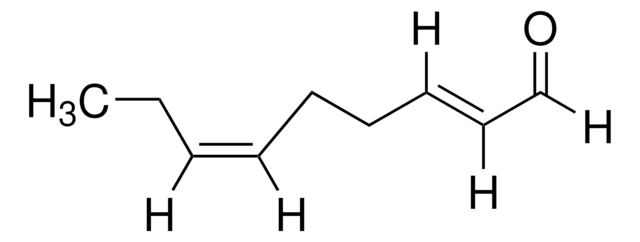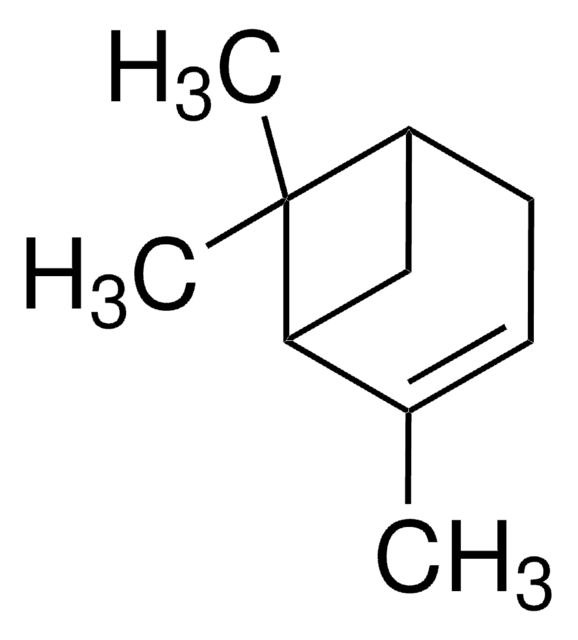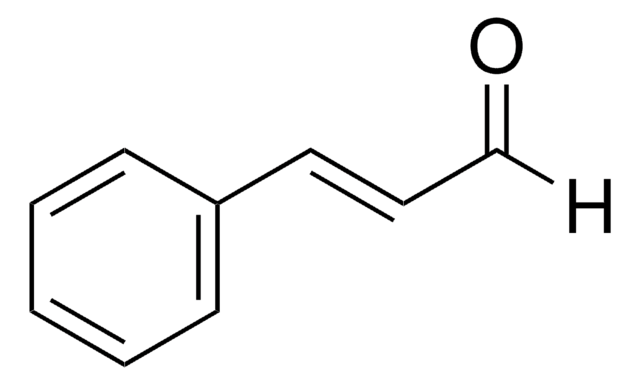W358002
cis-6-Nonenal
≥95%, FG
Synonym(s):
(Z)-non-6-enal
About This Item
Recommended Products
biological source
synthetic
Quality Level
grade
FG
Fragrance grade
Halal
Kosher
Agency
follows IFRA guidelines
meets purity specifications of JECFA
reg. compliance
EU Regulation 1223/2009
EU Regulation 1334/2008 & 178/2002
Assay
≥95%
refractive index
n20/D 1.442 (lit.)
bp
87 °C/19 mmHg (lit.)
density
0.841 g/mL at 25 °C (lit.)
application(s)
flavors and fragrances
Documentation
see Safety & Documentation for available documents
food allergen
no known allergens
fragrance allergen
no known allergens
Organoleptic
cucumber; green; melon; waxy
storage temp.
2-8°C
SMILES string
[H]C(=O)CCCC\C([H])=C(\[H])CC
InChI
1S/C9H16O/c1-2-3-4-5-6-7-8-9-10/h3-4,9H,2,5-8H2,1H3/b4-3-
InChI key
RTNPCOBSXBGDMO-ARJAWSKDSA-N
Application
- Anti-Methanogenic Traits of Safflower Oil Compounds Against Methyl-Coenzyme M Reductase Receptor in Equines: An In Silico Docking Analysis.: This study explores the potential of cis-6-Nonenal as a compound in safflower oil that exhibits anti-methanogenic properties. The in silico docking analysis highlights its application in reducing methane emissions in equines, contributing to environmental sustainability and agricultural practices (Khusro et al., 2022).
- The formation of highly oxidized multifunctional products in the ozonolysis of cyclohexene.: This research investigates the role of cis-6-Nonenal in the formation of highly oxidized multifunctional products during the ozonolysis of cyclohexene. The study provides insights into atmospheric chemistry and the processes involved in the formation of secondary organic aerosols, which have implications for air quality and climate change (Rissanen et al., 2014).
Signal Word
Warning
Hazard Statements
Precautionary Statements
Hazard Classifications
Eye Irrit. 2 - Skin Irrit. 2 - STOT SE 3
Target Organs
Respiratory system
Storage Class Code
10 - Combustible liquids
WGK
WGK 2
Flash Point(F)
235.4 °F - closed cup
Flash Point(C)
113 °C - closed cup
Personal Protective Equipment
Certificates of Analysis (COA)
Search for Certificates of Analysis (COA) by entering the products Lot/Batch Number. Lot and Batch Numbers can be found on a product’s label following the words ‘Lot’ or ‘Batch’.
Already Own This Product?
Find documentation for the products that you have recently purchased in the Document Library.
Customers Also Viewed
Our team of scientists has experience in all areas of research including Life Science, Material Science, Chemical Synthesis, Chromatography, Analytical and many others.
Contact Technical Service









